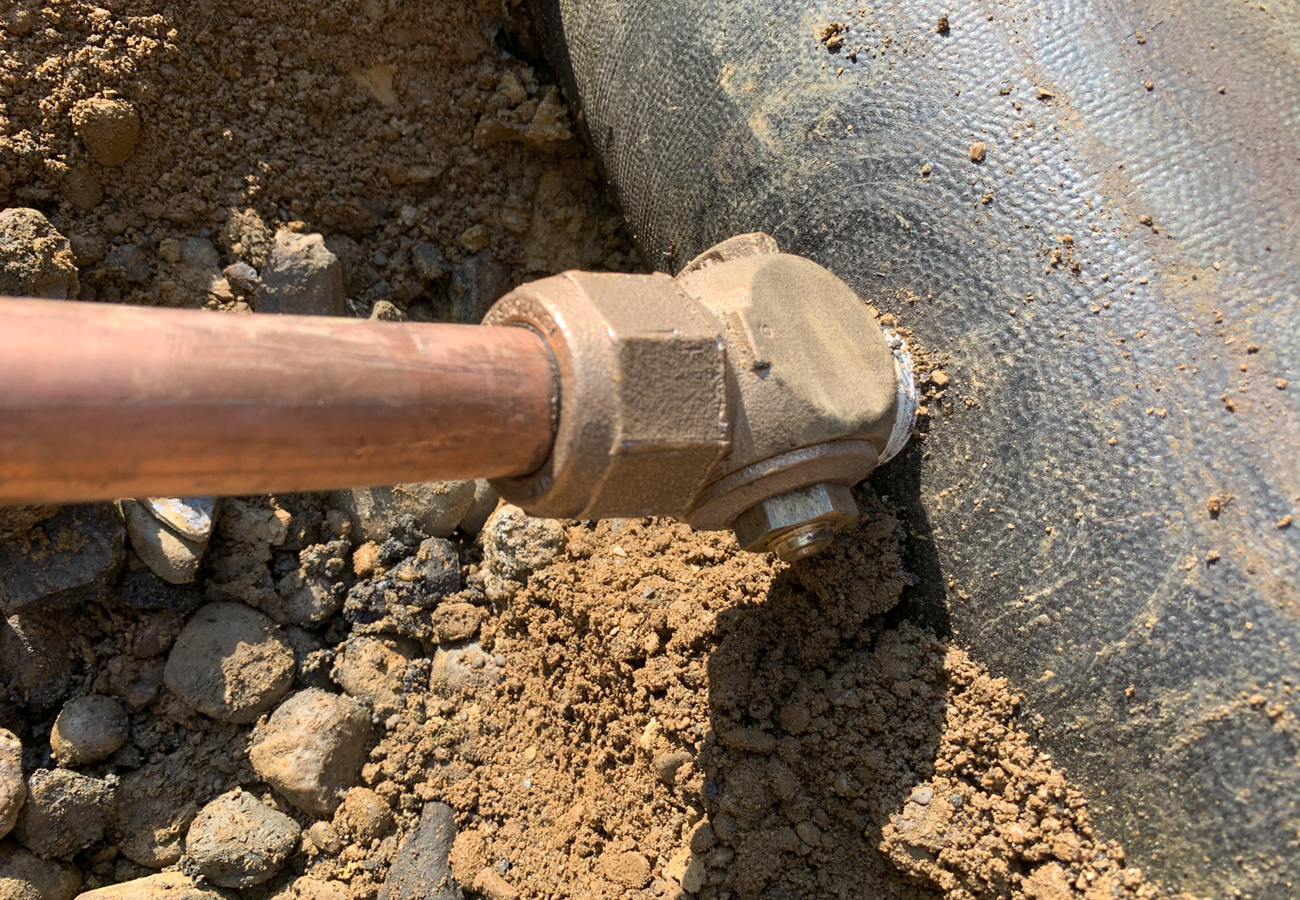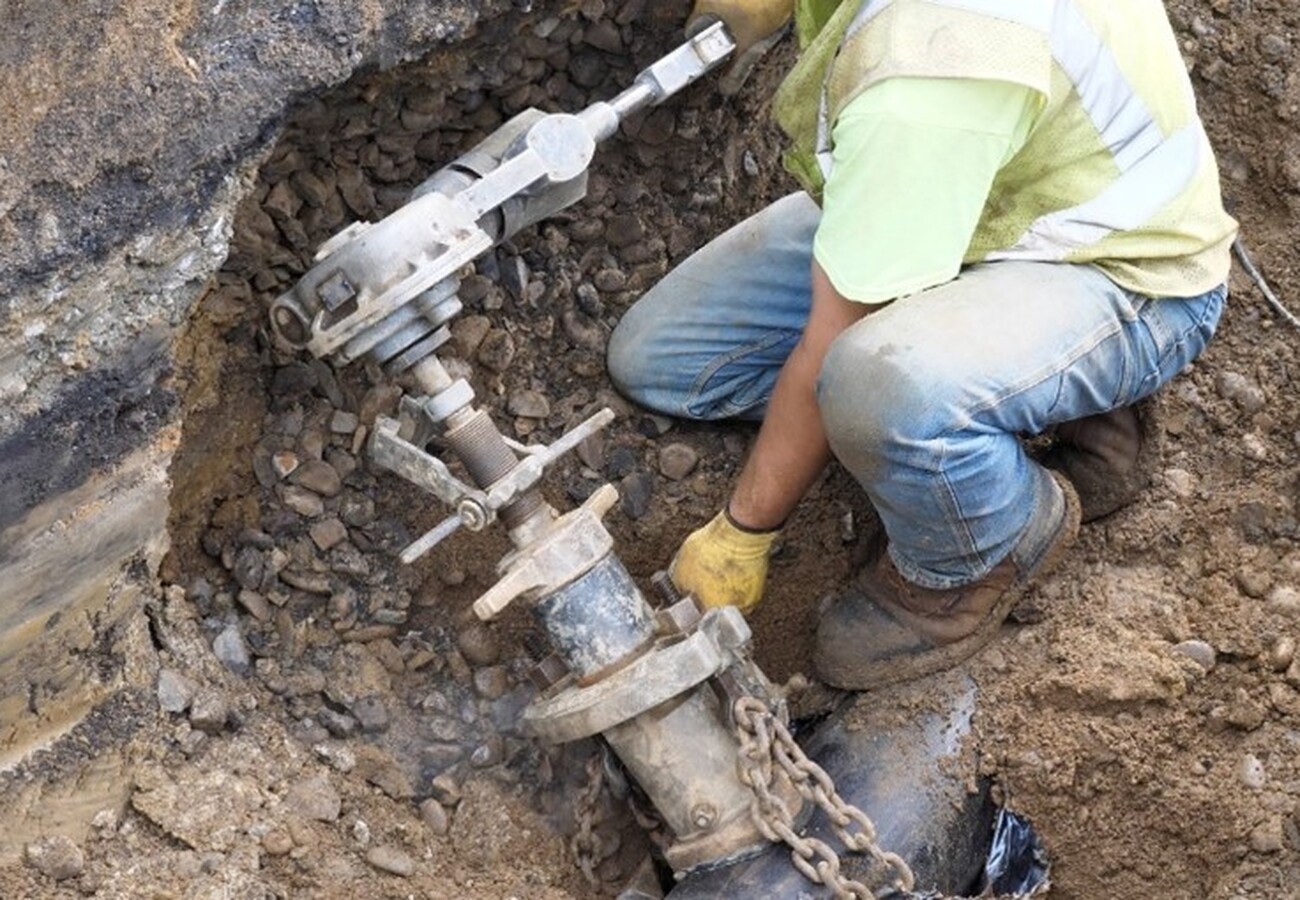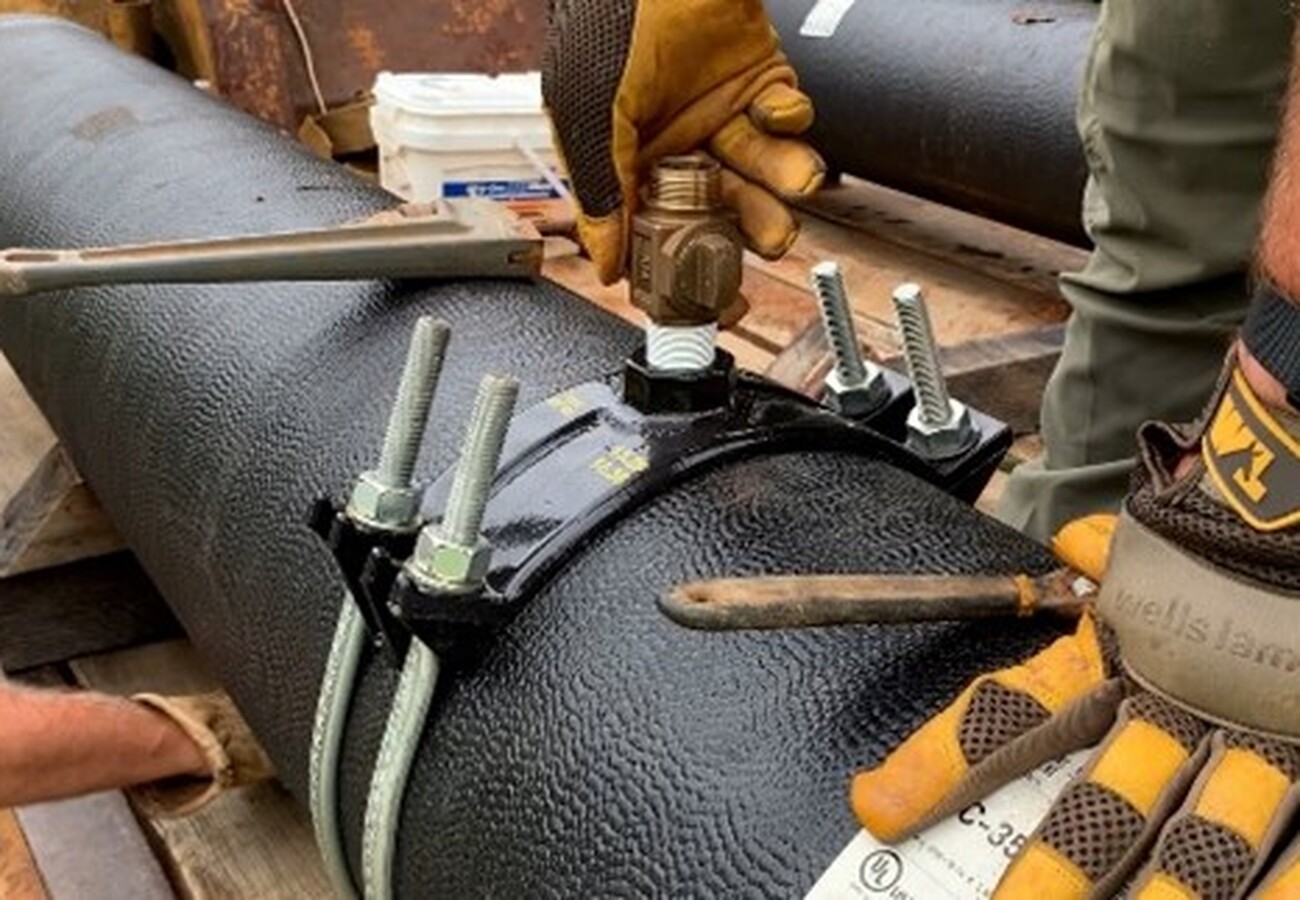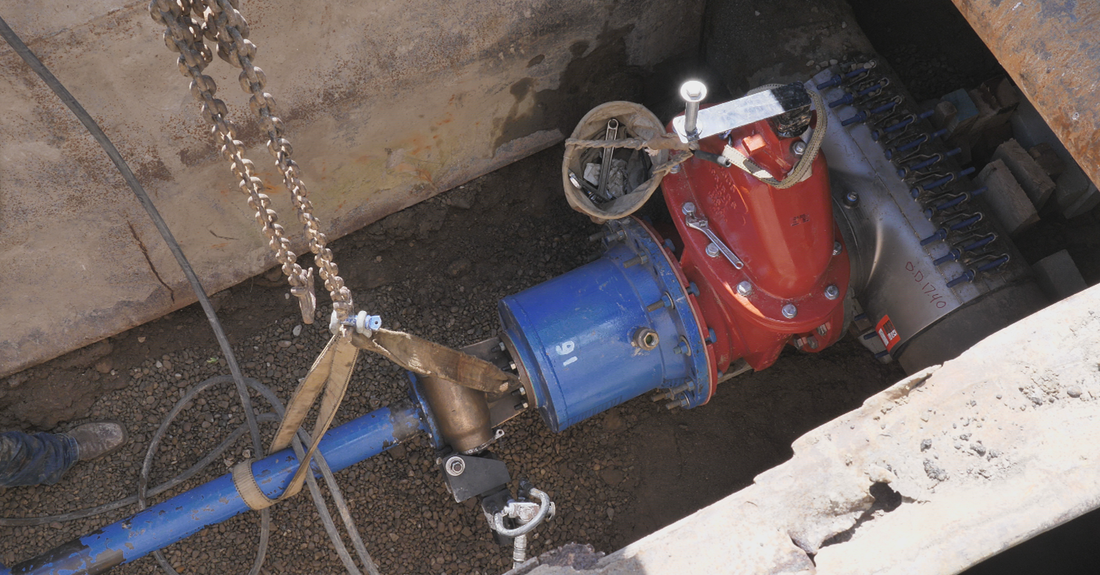So, you have an existing water distribution system feeding a small hospital and a military post. Now you need to branch off the pipeline to feed another 30 new houses under construction nearby. How do you do it without interrupting service to the critical facilities already being served? In this Iron Strong Blog, we’ll discuss three common pipe tapping methods used in the water and wastewater industry and the variables to consider when choosing the best method for your waterworks project.
What is Tapping and Why is it Necessary?
Tapping, also known as hot tapping or pressure tapping, allows a utility to tie into a pressurized system by drilling or cutting safely into an existing pipe. It involves placing a tapping fitting onto a water main, in addition to a gate or ball valve that will control water flow. At the same time, the water stream remains under pressure without interrupting or emptying the section of pipe. This means a pipeline can continue to operate while maintenance or modifications are being done to it.
The three methods of tapping are Direct Tap, Tapping Saddle, and Tapping Sleeve. These taps are typically installed to be used as "Service Taps" and may, in some cases, be installed in place of a Tee to provide an additional branch for a water system.
Key Considerations When Selecting the Tapping Method:
- Is the current line a new installation, or is the line in service?
- Safety considerations directly related to the type of pipe? Example: safety blanket for PVC.
- Safety considerations: location; trench box, electric or pneumatic drill?
- Project specifications: is one method specified over others?
- Size of pipe and size of the tap?
- What equipment will be used for various tapping methods?
- Have the installers been trained on proper tapping procedures?
- Is the tapping machine in good working order? Has maintenance been completed?
What is Direct Tapping?
Direct tapping involves the tapping of threads into the pipe wall and the insertion of a Corporation Stop. Generally, a hole is drilled into the pipe when a direct tap is created, and the threads are cut while using the same bit. This process allows for the installation of a corporation stop.

Direct Tapping Can Be Performed in Two Ways:
First, it can be performed on a new line before being placed in service. This method is known as a Dry Tap. Recommendation: Install Dry taps on new water lines after the completion of the required hydrostatic test.
How do I complete a successful Hydrostatic test? Click here for a helpful step-by-step blog with a video and a downloadable Tip Sheet.
The second method is known as a "Wet Tap." Wet tapping is the process of connecting a new service to an existing pipe installation without interrupting the service at any point. Services to homes, etc., connected to water lines that have been in service beyond their projected life typically remain in service until the new water line has been installed. New services are then installed and connected to the home. The homeowner, therefore, will see no interruption in service.
Tap Size
- Direct taps can be performed on any diameter Ductile iron pipe:
- 3-inch and 4-inch pipe ─ ¾ inch
- 6-inch through 10-inch pipe ─ 1 inch
- 12-inch thorough 16-inch pipe ─ 1 ¼ inch
- All classes of Ductile iron pipe 24 inches and larger in diameter can be direct tapped for 2-inch corporation stops. The cut-off at 2-inch diameter taps was chosen because most, if not all, tapping machines used to direct tap pressurized mains are limited to a maximum tap size of 2 inches. — DIPRA
-
Only AWWA Only AWWA C900 pressure Class 150 and 200 PVC pipes 6 in. (150mm) through 12 in. (300mm) can be direct tapped.
- Direct tapping is not recommended for Pressure Class 100 pipe, 4-in. Pressure Classes 150 and 200 pipe, AWWA C905, or AWWA C909 pipe. In these cases, service clamps or saddles should be used. ─ AWWA M23 Manual
For more information on tap size, check out this blog by Jeff Houser What is the Maximum Tap Size for Ductile Iron Pipe.
What if my Ductile Iron Pipeline is Encased in Polyethylene?
Service taps on Ductile iron mains encased in polyethylene may be accomplished by making an X-shaped cut in the polyethylene and temporarily folding back the film or, preferably, tapping directly through the polyethylene. After a tap has been completed, cuts or tears in the poly wrap and any other areas of damage to the film shall be repaired with tape as described in ANSI/AWWA C105/A21.5.
Equipment Required:
- Direct taps can be performed on Ductile iron using either a hand ratchet or a powered tap machine. Hand Ratchets to rotate the boring bar are recommended for PVC.
- Note: Dull Cutters can lead to “push through” at the inside diameter penetration, which may cause failures on the PVC line. AWWA M23 Manual
- A protective blanket is recommended for PVC per AWWA C905 9.4.4 Safety Precautions.
- To determine an accurate cost comparison for equipment needed, refer to DIPRA's extensive study, which stated, "Tapping DI Pipe versus PVC," that concluded PVC costs approximately $90 more in equipment.

What is Saddle Tapping?
Saddle tapping is the process of installing the service line to a main by a Corporation Stop. The corporation stop is screwed into a metal saddle that wraps around the pipe. When a pipe is saddle-tapped, equipment is attached to the corporation stop that permits a cutting tool to be fed through the stop to cut a hole in the pipe. During this process, the pipe wall is not threaded as the corporation stop is installed /“threaded” into the tapping saddle.
When using Saddles, an essential factor to consider is the pipe's Standard Dimension Ratio (SDR). HDPE pipe with an SDR number greater than 17 (SDR 19, 21, 26, 32.5) has a lesser wall thickness and can be subject to flexing.
Extra considerations should be made when selecting Service clamps or Saddles for PVC. Service saddles /clamps should not have;
- Lugs that ding into the pipe when the saddle is tightened
- A U-bolt type of strap that does not provide sufficient bearing area
- A clamping arrangement that is not fully contoured to the outside diameter of the pipe
These extra strapping considerations are not required for Ductile iron.
The maximum outlet size with a service clamp or saddle shall be 2 inches. If a tap larger than 2 inches is required, a tapping sleeve and valve shall be used. — AWWA M23 Manual

Tapping Sleeves
A tapping sleeve allows access to and the branching of an existing water main. Tapping sleeves can be used on Ductile iron pipe and alternate pipe materials. The benefits of using Tapping Sleeves are the size and stability of the sleeve. The branch may be well above the sizing for the Direct taps. The sleeve length makes this a good option when tapping PVC and HDPE, as the hoop strength of the sleeve may exceed that of the pipe. The downsides to using Tapping Sleeves are an additional cost for the sleeve and increased installation time which elevates costs.
Unlike DI pipe, direct threading of polyethylene pipe is not recommended. Sidewall fusion is the recommended method when installing service connections on polyethylene pipe. The fusion process requires specialty tools, an AC power source, and specific weather conditions. These factors can significantly affect the time and cost-efficiency of your project.
Another study performed by DIPRA, Direct Service Connection Installation Comparison DI pipe vs. Polyethylene Pipe, concluded that the average time to tap DI pipe was 15.67 minutes compared to an average of 69 minutes to tap into HDPE pipe.

Conclusion
We have looked at the three methods of tapping water lines. Direct tapping is the most common and cost-effective method of the three. Tapping Saddles and Sleeves increase the project's overall cost as both methods will increase the cost of materials, installation costs, and the use of dissimilar metals in the system. When it comes to service connections with Ductile iron, you save time and money. Most importantly, you have a secure connection when properly installed.
With the rate at which our communities and businesses continue to grow, along with their expectations for uninterrupted water service, the need to tap an existing water line will arise. Careful consideration of all three tapping methods will increase the potential for successful project completion and long-term system service.
Need Assistance with Your Waterworks Project?
If you have any questions regarding your water or wastewater infrastructure project, be sure to reach out to your local McWane Ductile representative. We have team members who've managed small and large water utility systems, served in engineering consulting firms, and bring decades of experience in solving field issues involving pipeline construction and operation. From design to submittal to installation, we strive to provide education and assistance to water professionals throughout the water and wastewater industry.







